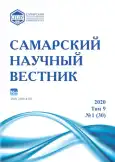Эколого-ценотические группы (ценоморфы) А.Л. Бельгарда - Н.М. Матвеева для лесостепи и степи Поволжского региона
- Авторы: Назаренко Н.Н.1, Похлебаев С.М.1
-
Учреждения:
- Южно-Уральский государственный гуманитарно-педагогический университет
- Выпуск: Том 9, № 1 (2020)
- Страницы: 79-84
- Раздел: Общая биология
- URL: https://bakhtiniada.ru/2309-4370/article/view/34541
- DOI: https://doi.org/10.17816/snv202091112
- ID: 34541
Цитировать
Полный текст
Аннотация
Рассмотрена система ценоморф видов сосудистых растений А.Л. Бельгарда, предложенная Н.М. Матвеевым для флоры Поволжского региона. Оценка предложенной системы ценоморф проведена для 752 видов сосудистых растений флоры с использованием экспертно-статистического подхода - проверка трех вариантов выделения групп (по Н.М. Матвееву и по А.Л. Бельгарду с выделением галофитов и псаммофитов и без них) методами дискриминантного анализа с использованием фитоиндикационных шкал видов. Доказана возможность дать балловые оценки ценоморфам А.Л. Бельгарда, выделенным Н.М. Матвеевым для Поволжского региона, в фитоиндикационных шкалах. Определены оптимумы выделенных ценоморф по 12 эдафическим и климатическим факторам. Установлено, что для флоры Поволжского региона необходимо выделение ценоморф галофитов, связанных с мезофитными биотопами неравномерного увлажнения с неглубоким промачиванием корнеобитаемого горизонта на слабощелочных - щелочных почвах со слабым засолением карбонатно-сульфатного типа, и псаммофитов как индикаторов мезоксерофильных биотопов на слабокислых почвах, бедных минеральным азотом. Предложенные Н.М. Матвеевым сорно-степная, сорно-луговая и сорно-лесная ценоморфы не являются специфическими эколого-ценотическими группами, не определяются как рудеральные (сорные), и выделение их в отдельные ценоморфы не целесообразно. Указанные группы видов могут использоваться при анализе растительности региона в качестве индикаторов биотопов: сорно-степная - бедных карбонатами степных, сорно-луговая - мезофитных луговых, сорно-лесная - не теневых (полутеневых - полуосветленных) лесных.
Полный текст
Открыть статью на сайте журналаОб авторах
Назар Николаевич Назаренко
Южно-Уральский государственный гуманитарно-педагогический университет
Email: nnazarenko@hotmail.com
доктор биологических наук, профессор кафедры химии, экологии и методики обучения химии
Россия, ЧелябинскСергей Михайлович Похлебаев
Южно-Уральский государственный гуманитарно-педагогический университет
Автор, ответственный за переписку.
Email: istina48@mail.ru
доктор педагогических наук, профессор кафедры общей биологии и физиологии
Россия, ЧелябинскСписок литературы
- Ниценко А.А. Об изучении экологической структуры растительного покрова // Ботанический журнал. 1969. Т. 54, № 7. С. 1002-1013.
- Восточноевропейские леса: история в голоцене и современность. Кн. 1 / под ред. О.В. Смирновой. М.: Наука, 2004. 479 с.
- Зозулин Г.М. Исторические свиты растительности Европейской части СССР // Ботанический журнал. 1973. Т. 58, № 8. С. 1081-1092.
- Цыганов Д.Н. Экоморфы флоры хвойно-широколиственных лесов. М.: Наука, 1976. 60 с.
- Каразия С. Фитоцено-экологические группы растений лесов Литовской ССР // Труды Литовского НИИ лесного хозяйства. 1977. Т. 17. С. 3-10.
- Сабуров Д.Н. Опыт классификации луговой растительности Центральной России по эколого-ценотическим группам // Бюллетень МОИП. Отдел биологический. 1984. Т. 89, вып. 1. С. 72-81.
- Martinez K.A., Gibson D.J., Middleton B.A. Core-satellite species hypothesis and native versus exotic species in secondary succession // Plant Ecology. 2015. Vol. 216 (3). P. 419-427.
- Цыганов Д.Н. Экоморфы и экологические свиты // Бюллетень МОИП. Отдел биологический. 1974. Т. 79, вып. 2. С. 128-139.
- Бельгард А.Л. Лесная растительность юго-востока УССР. К.: КГУ, 1950. 263 с.
- Назаренко Н.Н. Ценоморфы как фитоиндикаторы биотопов // Вісник Дніпропетровського університету. Біологія, екологія. 2016. Вип. 24, т. 1. С. 8-14.
- Назаренко Н.Н. Ценоморфы флоры степной зоны Южного Урала (на примере Челябинской области) // Вестник Тамбовского университета. Серия: Естественные и технические науки. 2016. Т. 21, вып. 5. С. 1889-1896.
- Дрогунова М.С., Назаренко Н.Н. Ценоморфы флоры Тамбовской области и фитоиндикация биотопов // Вестник Тамбовского университета. Серия: Естественные и технические науки. 2017. Т. 22, вып. 5. С. 780-786.
- Назаренко Н.Н., Пасечнюк Е.Ю. Различные методические подходы к классификации эколого-ценотических групп (на примере флоры сосудистых растений Ханты-Мансийского автономного округа - Югра) // Acta Biologica Sibirica. 2019. Т. 5, № 2. С. 119-133.
- Искусственные леса степной зоны Украины. Харьков: ХГУ, 1960. 423 с.
- Тарасов В.В. Флора Дніпропетровської і Запорізької областей. Видання друге. Доповнене та виправлене. Дніпропетровськ: Ліра, 2012. 296 с.
- Матвеев Н.М. Биоэкологический анализ флоры и растительности (на примере лесостепной и степной зоны). Самара: Издательство «Самарский университет», 2006. 311 с.
- Матвеев Н.М. Оптимизация системы экоморф растений А.Л. Бельгарда в целях фитоиндикации экотопа и биотопа // Вісник Дніпропетровського університету. Біологія, екологія. 2003. Вип. 11, т. 2. С. 105-113.
- Смирнов В.Э., Ханина Л.Г., Бобровский М.В. Обоснование системы эколого-ценотических групп видов растений лесной зоны Европейской России на основе экологических шкал, геоботанических описаний и статистического анализа // Бюллетень МОИП. Отдел биологический. 2006. Т. 111, вып. 2. С. 36-47.
- Didukh Ya.P. The ecological scales for the species of Ukrainian flora and their use in synphytoindication. Kyiv: Phytosociocentre, 2011. 176 p.
Дополнительные файлы






